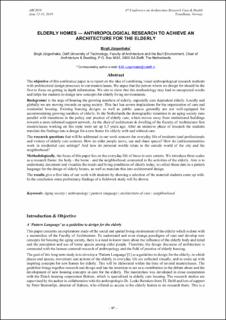| dc.contributor.author | Jürgenhake, Birgit | |
| dc.date.accessioned | 2021-12-27T18:30:44Z | |
| dc.date.available | 2021-12-27T18:30:44Z | |
| dc.date.issued | 2021 | |
| dc.identifier.isbn | 978-82-536-1718-3 | |
| dc.identifier.issn | 2387-4295 | |
| dc.identifier.uri | https://hdl.handle.net/11250/2835486 | |
| dc.description.abstract | The objective of this conference paper is to report on the idea of combining visual anthropological research methods with architectural design processes in our masterclasses. We argue that the person whom we design for should be the first to focus on getting in depth information. We aim to show that this methodology may lead to unexpected results and helps the students to design new concepts for elderly living environments.
Background is the urge of housing the growing numbers of elderly, especially care dependent elderly. Locally and globally we are moving towards an aging society. This fact has severe implications for the organization of care and residential housing. Existing housing designs as well as public spaces generally are not well-equipped for accommodating growing numbers of elderly. In the Netherlands the demographic transition to an aging society runs parallel with transitions in the policy and practice of elderly care, which moves away from institutional buildings towards a more informal support network. As the chair of architecture & dwelling of the Faculty of Architecture first masterclasses working on this topic were set up 1,5 years ago. After an intensive phase of research the students translate the findings into a design for a new home for elderly with and without care.
The research questions that will be addressed in our work concern the everyday life of residents (and professionals and visitors of elderly care centers). How do older people move, use and share spaces? How do (sub)communities work in residential care settings? And how do personal worlds relate to the outside world of the city and the neighborhood?
Methodologically, the focus of this paper lies on the everyday life of those in care centers. We introduce three scales as a research frame: the body - the home - and the neighborhood, connected to the activities of the elderly. Aim is to understand, document and visualize the needs and living conditions of elderly today, to collect these data in a pattern language for the design of elderly homes, as well as translate this into architectural design.
The results give a first idea of our work with students by showing a selection of the material students came up with. In the conclusion some preliminary findings of a fieldwork study will be shown. | |
| dc.language.iso | eng | |
| dc.publisher | SINTEF Academic Press | |
| dc.relation.ispartof | ARCH19 June 12–13, 2019 – Trondheim, Norway. Proceedings from the 4th Conference on Architecture Research Care & Health | |
| dc.relation.ispartofseries | SINTEF Proceedings;8 | |
| dc.rights | CC BY 4.0 | |
| dc.rights.uri | https://creativecommons.org/licenses/by/4.0/ | |
| dc.subject | Aging society | |
| dc.subject | Anthropology | |
| dc.subject | Pattern language | |
| dc.subject | Architecture of care | |
| dc.subject | Neighborhood | |
| dc.title | Elderly Homes —Anthropological Research to Achieve an Architecture for the Elderly | |
| dc.type | Chapter | |
| dc.type | Peer reviewed | |
| dc.type | Conference object | |
| dc.description.version | publishedVersion | |
| dc.rights.holder | © 2021 The Authors. | |
| dc.subject.nsi | VDP::Medisinske Fag: 700::Helsefag: 800 | |

